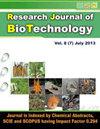通过生物活性引导分馏评估神经保护作用并鉴定芝麻中的活性化合物
IF 0.2
Q4 BIOTECHNOLOGY & APPLIED MICROBIOLOGY
引用次数: 0
摘要
兰科药草 Nigella sativa Linn 在世界各地被广泛使用。过去,许多疾病都是用 N. sativa L. 种子治疗的。体内和体外分析表明,N. sativa L. 具有多种神经保护作用。对 N. sativa L. 的甲醇提取物进行了抗氧化和抗胆碱酯酶活性评估,结果表明该提取物具有出色的抗氧化和抗胆碱酯酶活性。由于发现该提取物具有出色的活性,因此借助生物活性引导分馏技术,使用柱层析法对甲醇提取物进行了分离。总共收集了 19 个馏分,并对其抗氧化潜力进行了分析。对活性馏分进行收集、汇集,并使用 LC-MS 技术进行分析。结果显示存在堪非醇 3-(2-galloyl-alpha-L-阿拉伯吡喃糖苷)。为了评估甲醇提取物的安全性,使用斑马鱼进行了亚急性毒性试验。肝功能测试和组织结构分析的结果表明,甲醇提取物没有产生不良后果。总之,这些结果表明,N. sativa L. 是一种很有前景的治疗阿尔茨海默病的药物。本文章由计算机程序翻译,如有差异,请以英文原文为准。
Evaluation of neuroprotective effect and identification of active compounds from Nigella sativa Linn. through bioactive guided fractionation
The medicinal herb Nigella sativa Linn of the Ranunculaceae family is widely used everywhere in the world. In the past, numerous illnesses and disorders have been treated with N. sativa L. seeds. Both in vivo and in vitro analyses revealed that N. sativa L., possesses numerous neuroprotective effects. The methanolic extract of N. sativa L. was evaluated for the presence of antioxidant and anticholinesterase activity and the findings revealed that the extract has outstanding antioxidant and anticholinesterase activity. Since the extract was found to possess excellent activity, the methanolic extract was separated using column chromatography with the aid of bioactive guided fractionation. A total of 19 fractions were collected and analyzed for antioxidant potential. The active fractions were collected, pooled and analyzed using LC-MS techniques. The outcomes revealed the existence of Kaempferol 3-(2-galloyl-alpha-L-arabinopyranoside). To assess the safety aspects of methanolic extract, a subacute toxicity test was performed using zebrafish. The results of the liver function test and histoarchitecture analysis found that there were no adverse consequences from the extract. Altogether, these results suggest that N. sativa L., could be a promising therapeutic drug against Alzheimer’s disease.
求助全文
通过发布文献求助,成功后即可免费获取论文全文。
去求助
来源期刊

Research Journal of Biotechnology
BIOTECHNOLOGY & APPLIED MICROBIOLOGY-
CiteScore
0.60
自引率
0.00%
发文量
192
期刊介绍:
We invite you to contribute Research Papers / Short Communications / Review Papers:
-In any field of Biotechnology, Biochemistry, Microbiology and Industrial Microbiology, Soil Technology, Agriculture Biotechnology.
-in any field related to Food Biotechnology, Nutrition Biotechnology, Genetic Engineering and Commercial Biotechnology.
-in any field of Biotechnology related to Drugs and Pharmaceutical products for human beings, animals and plants.
-in any field related to Environmental Biotechnolgy, Waste Treatment of Liquids, Soilds and Gases; Sustainability.
-in inter-realted field of Chemical Sciences, Biological Sciences, Environmental Sciences and Life Sciences.
-in any field related to Biotechnological Engineering, Industrial Biotechnology and Instrumentation.
-in any field related to Nano-technology.
-in any field related to Plant Biotechnology.
 求助内容:
求助内容: 应助结果提醒方式:
应助结果提醒方式:


